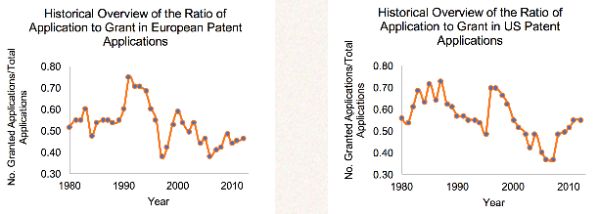Fluctuations in patent activity provide insight into trends which can have major implications for people and organisations who deal with Intellectual Property. These implications range from research and development planning, to developing effective marketing strategies locally and internationally. It is important, therefore, to understand patent filing drivers and factors influencing these drivers.
One factor is a technical breakthrough which opens the way for new research in a previously moribund field. Another factor is corporate competition, which can drive large entities to develop defensive portfolios of patents in order to gain an edge in a contested market. A third factor may be where the field of technology is small enough so that the entry of a new actor causes a relative of a flurry of activity in this smaller space. Finally; there are cases where the cause of an increasing trend seems to be inexplicable and driven by a confluence of factors which resist easy explanation.
Cases where fields of technology are stagnant or in decline may be just as important as they may point to a general dynamic affecting an entire industry. Often there is a general trend towards fewer successful granted patents per patent application over time. This effect may occur as a simple result of accumulating prior art with publications raising the hurdles a new patent application must clear in order to be considered novel and inventive. In other cases, a lower number of successful applications may be a result of changes in the patent laws and regulations; as examination processes become more intensive and costly. The dynamics of such cases are important to identify and understand as they imply that the chances of obtaining highly sought-after exclusive rights over the fruits of research and development become more and more limited.
Here it should be mentioned that the number of patent applications being filed every year has been growing steadily in all jurisdictions and spheres of technology, as has the number of granted patents. However, what seems like robust growth may conceal relative increases or decreases. The field of telecommunications, for example, has seen increasing numbers of granted patents per published patent over time: from around 50% in the early 1980s to over 70% for patent applications published after 2010. This trend has not been steady but has involved numerous peaks and troughs as the industry and technology has changed. These changes reflect two periods of intense activity in the field: one beginning in the mid-1990's and another taking off around 2005. This activity would not be obvious at first glance, though as patent publications in telecommunications have actually declined overall since 2005 after decades of steady increases. Due to this perceived decline, the uninformed could be swayed to slow research and development in a sector which may present opportunities for effective intellectual property development.
Changes in patent filings and grants do not occur in isolation and should be understood in terms of the overall trends in patent law and prosecution. Worldwide the number of patents granted per published application has slowly been rising: from around 35% in the early 1980s to around 55% after 2010. This trend has not been constant, however. Similarly' trends in various jurisdictions are variable and can only be generalised about in broad terms. Applications filed in both the European Patent Office and the United States Patent and Trademark Office, for instance, are about as likely to succeed now as they were 30 years ago after having gone through various peaks and troughs.

It is important to note that these trends are not just of interest to patent professionals. Analysis of the patterns hidden in patent filing offices can provide guidance to researchers, corporations and other organisations about the field of technology they are operating in, and the strategic options available to them for protection of their intellectual property. This sort of information, which falls under the broad rubric of 'patent landscaping', is expected to become more important for decision-makers as both the opportunities and costs of patent filings increase.
The content of this article is intended to provide a general guide to the subject matter. Specialist advice should be sought about your specific circumstances.

